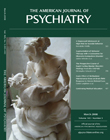In This Issue
d -Cycloserine Boosts Behavior Therapy for Obsessive-Compulsive Disorder
Midway through a 10-session course of behavior therapy for obsessive-compulsive disorder (OCD), symptom levels were lower for patients who received 100 mg of d -cycloserine 1 hour before each behavioral treatment than for patients who received placebo instead. Although a between-group difference was not evident at the end of treatment or at 1-month follow-up, Wilhelm et al. (CME, p. Original article: 335 ) point out that d -cycloserine’s acceleration of response could reduce patient anxiety, encourage treatment completion, and allow shorter courses of behavior therapy. Indeed, patients who received the drug were less depressed at the conclusion of the study. The clinical findings also support the role of the N -methyl- d -aspartic acid (NMDA) subtype of the glutamate receptor in behavioral extinction, since d -cycloserine was selected because it is a co-agonist of the NMDA receptor. Dr. Barbara Rothbaum discusses pharmacologic treatment enhancers in an editorial on p. Original article: 293 .

Treatment Outcome in Anxious Depression
Remission was less common among depressed patients with high anxiety levels than among those with nonanxious depression—22% versus 33% —in level 1 of the Sequenced Treatment Alternatives to Relieve Depression (STAR*D) project. Furthermore, remission during the initial citalopram trial occurred later for patients with anxious depression, who also had more numerous and more serious adverse events. More than half of the 2,876 patients in level 1 had anxious depression, and the analysis by Fava et al. (p. Original article: 342 ) revealed links to several sociodemographic and clinical characteristics, including comorbid psychiatric and general medical conditions. These patients also had worse outcomes in STAR*D level 2, regardless of whether they switched treatments or received a second medication. Dr. J. Craig Nelson comments on these differences in an editorial on p. Original article: 297 .
Rapid-Cycling Bipolar Disorder Over Time
A year-long follow-up of 1,742 patients treated for bipolar disorder demonstrated that rapid cycling, defined as four or more mood episodes per year, was rare but that 27% of the patients had “frequent cycling,” i.e., two or three episodes. In the Systematic Treatment Enhancement Program for Bipolar Disorder (STEP-BD), two-thirds of the patients had one or more episodes in the follow-up year. Patients with previous rapid cycling were more likely to have rapid cycling during follow-up, and Schneck et al. (CME, p. Original article: 370 ) report that rapid cycling was also associated with greater baseline clinical severity. Antidepressant use was consistently associated with more frequent cycling, but gender, bipolar subtype, and age at illness onset were not significant when other factors were considered. An editorial by Nassir Ghaemi on p. Original article: 300 focuses on antidepressant use for bipolar disorder.
Vulnerability in Methadone Maintenance
Former heroin users receiving daily methadone demonstrate heightened responsiveness to drug-related cues near the end of the 24-hour interval between methadone doses. Langleben et al. (p. Original article: 390 ) measured the brain activity of 25 methadone maintenance patients twice over 3–4 weeks. One imaging session was 90 minutes before the methadone dose, when the methadone plasma concentration was near its lowest, and the other session was 90 minutes after the dose, when the plasma concentration was near peak. Brain activation during these sessions was measured as the response to images of heroin use relative to the response to neutral images. The bilateral orbitofrontal cortex, insulae, and hippocampus and the left amygdala showed greater responses to the heroin-related images immediately before receiving their next methadone dose, compared to afterwards. These regions are similar to those previously identified in brain imaging studies of untreated heroin dependence. Dr. Bryon Adinoff addresses split methadone dosing in an editorial on p. Original article: 303 .



